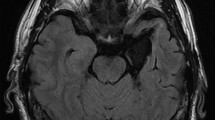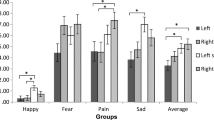Abstract
With the objective to investigate the role of the insula in recognizing emotion, we performed direct electrical stimulation over the anterior insular cortex during awake surgery while simultaneously delivering an emotional sensitivity task. We registered 18 consecutive patients with brain tumors associated with the insular lobe, who were undergoing tumor resection. An emotional sensitivity task was employed to measure the patients’ ability to recognize emotions from facial expressions before, during, and after awake surgery. Furthermore, we performed voxel-based lesion symptom mapping (VLSM) to identify the association between relevant brain lesions and emotion recognition. When we performed direct electrical stimulation over the anterior insular cortex during awake surgery, the results showed that the ability to recognize anger was significantly enhanced with the presence of anterior insular stimulation (p < 0.05). Comparing the performance in the emotional sensitivity task before and after surgery, the performance in the anger condition became worse (p < 0.01), but became better in the sadness condition after surgery (p < 0.01). In the case of anger recognition, lower scores in the correct response index were associated with lesions involving the left insula in the VLSM study. Direct electrical stimulation over the anterior insular cortex enhanced anger recognition in patients with insular tumors. In contrast, accuracy of anger recognition was significantly reduced, and sadness was improved, when the performance of emotional sensitivity was compared pre- and post-surgery. Our findings suggest that the insular cortex is involved in changes in emotion recognition, including anger and sadness recognition by modulating arousal level that is closely connected with interoception.




Similar content being viewed by others
References
Adolphs R, Damasio H, Tranel D, Cooper G, Damasio AR (2000) A role for somatosensory cortices in the visual recognition of emotion as revealed by three-dimensional lesion mapping. J Neurosci 20(7):2683–2690
Adolphs R, Tranel D, Damasio AR (2003) Dissociable neural systems for recognizing emotions. Brain Cogn 52(1):61–69
Barbey AK, Colom R, Paul EJ, Chau A, Solomon J, Grafman JH (2014) Lesion mapping of social problem solving. Brain 137(Pt 10):2823–2833. https://doi.org/10.1093/brain/awu207
Bates E, Wilson SM, Saygin AP, Dick F, Sereno MI, Knight RT, Dronkers NF (2003) Voxel-based lesion–symptom mapping. Nat Neurosci 6(5):448–450. https://doi.org/10.1038/nn1050
Bello L, Gallucci M, Fava M, Carrabba G, Giussani C, Acerbi F, Baratta P, Songa V, Conte V, Branca V, Stocchetti N, Papagno C, Gaini SM (2007) Intraoperative subcortical language tract mapping guides surgical removal of gliomas involving speech areas. Neurosurg 60(1):67–80. https://doi.org/10.1227/01.neu.0000249206.58601.de (Discussion 80–62)
Bernard F, Lemee JM, Ter Minassian A, Menei P (2018) Right hemisphere cognitive functions: from clinical and anatomic bases to brain mapping during awake craniotomy part I: clinical and functional anatomy. World Neurosurg 118:348–359. https://doi.org/10.1016/j.wneu.2018.05.024
Berntson GG, Norman GJ, Bechara A, Bruss J, Tranel D, Cacioppo JT (2011) The insula and evaluative processes. Psychol Sci 22(1):80–86. https://doi.org/10.1177/0956797610391097
Bijanki KR, Kovach CK, McCormick LM, Kawasaki H, Dlouhy BJ, Feinstein J, Jones RD, Howard MA 3rd (2014) Case report: stimulation of the right amygdala induces transient changes in affective bias. Brain Stimul 7(5):690–693. https://doi.org/10.1016/j.brs.2014.05.005
Borg C, Bedoin N, Peyron R, Bogey S, Laurent B, Thomas-Anterion C (2013) Impaired emotional processing in a patient with a left posterior insula-SII lesion. Neurocase 19(6):592–603. https://doi.org/10.1080/13554794.2012.713491
Boucher O, Rouleau I, Lassonde M, Lepore F, Bouthillier A, Nguyen DK (2015) Social information processing following resection of the insular cortex. Neuropsychol 71:1–10. https://doi.org/10.1016/j.neuropsychologia.2015.03.008
Calder AJ, Keane J, Manes F, Antoun N, Young AW (2000) Impaired recognition and experience of disgust following brain injury. Nat Neurosci 3(11):1077–1078. https://doi.org/10.1038/80586
Campanella F, Shallice T, Ius T, Fabbro F, Skrap M (2014) Impact of brain tumour location on emotion and personality: a voxel-based lesion–symptom mapping study on mentalization processes. Brain 137(Pt 9):2532–2545. https://doi.org/10.1093/brain/awu183
Catani M, Ffytche DH (2005) The rises and falls of disconnection syndromes. Brain 128(Pt 10):2224–2239. https://doi.org/10.1093/brain/awh622
Catani M, Dell’acqua F, Vergani F, Malik F, Hodge H, Roy P, Valabregue R, Thiebaut de Schotten M (2012) Short frontal lobe connections of the human brain. Cortex 48(2):273–291. https://doi.org/10.1016/j.cortex.2011.12.001
Craig AD (2002) How do you feel? Interoception: the sense of the physiological condition of the body. Nat Rev Neurosci 3(8):655–666. https://doi.org/10.1038/nrn894
Critchley HD, Harrison NA (2013) Visceral influences on brain and behavior. Neuron 77(4):624–638. https://doi.org/10.1016/j.neuron.2013.02.008
Dal Monte O, Krueger F, Solomon JM, Schintu S, Knutson KM, Strenziok M, Pardini M, Leopold A, Raymont V, Grafman J (2013) A voxel-based lesion study on facial emotion recognition after penetrating brain injury. Soc Cogn Affect Neurosci 8(6):632–639. https://doi.org/10.1093/scan/nss041
D’Angelo C, Mirijello A, Leggio L, Ferrulli A, Carotenuto V, Icolaro N, Miceli A, D’Angelo V, Gasbarrini G, Addolorato G (2008) State and trait anxiety and depression in patients with primary brain tumors before and after surgery: 1-year longitudinal study. J Neurosurg 108(2):281–286. https://doi.org/10.3171/JNS/2008/108/2/0281
De Benedictis A, Duffau H (2011) Brain hodotopy: from esoteric concept to practical surgical applications. Neurosurg 68(6):1709–1723. https://doi.org/10.1227/neu.0b013e3182124690 (Discussion 1723)
Dennis EL, Jahanshad N, McMahon KL, de Zubicaray GI, Martin NG, Hickie IB, Toga AW, Wright MJ, Thompson PM (2013) Development of insula connectivity between ages 12 and 30 revealed by high angular resolution diffusion imaging. Hum Brain Mapp. https://doi.org/10.1002/hbm.22292
Duffau H (2010) Awake surgery for nonlanguage mapping. Neurosurgery 66(3):528–529. https://doi.org/10.1227/01.neu.0000364996.97762.73 (Discussion 528–529)
Duffau H (2018) Is non-awake surgery for supratentorial adult low-grade glioma treatment still feasible? Neurosurg Rev 41(1):133–139. https://doi.org/10.1007/s10143-017-0918-9
Duffau H, Peggy Gatignol ST, Mandonnet E, Capelle L, Taillandier L (2008) Intraoperative subcortical stimulation mapping of language pathways in a consecutive series of 115 patients with grade II glioma in the left dominant hemisphere. J Neurosurg 109(3):461–471. https://doi.org/10.3171/JNS/2008/109/9/0461
Duffau H, Moritz-Gasser S, Gatignol P (2009) Functional outcome after language mapping for insular World Health Organization grade II gliomas in the dominant hemisphere: experience with 24 patients. Neurosurg Focus 27(2):E7. https://doi.org/10.3171/2009.5.FOCUS0938
Eckert MA, Menon V, Walczak A, Ahlstrom J, Denslow S, Horwitz A, Dubno JR (2009) At the heart of the ventral attention system: the right anterior insula. Hum Brain Mapp 30(8):2530–2541. https://doi.org/10.1002/hbm.20688
Eseonu CI, Rincon-Torroella J, ReFaey K, Lee YM, Nangiana J, Vivas-Buitrago T, Quinones-Hinojosa A (2017) Awake craniotomy vs craniotomy under general anesthesia for perirolandic gliomas: evaluating perioperative complications and extent of resection. Neurosurgery 81(3):481–489. https://doi.org/10.1093/neuros/nyx023
Evans KC, Banzett RB, Adams L, McKay L, Frackowiak RS, Corfield DR (2002) BOLD fMRI identifies limbic, paralimbic, and cerebellar activation during air hunger. J Neurophysiol 88(3):1500–1511. https://doi.org/10.1152/jn.2002.88.3.1500
Feindel W, Penfield W (1954) Localization of discharge in temporal lobe automatism. AMA Arch Neurol Psychiatry 72(5):603–630
Feinstein JS, Khalsa SS, Salomons TV, Prkachin KM, Frey-Law LA, Lee JE, Tranel D, Rudrauf D (2016) Preserved emotional awareness of pain in a patient with extensive bilateral damage to the insula, anterior cingulate, and amygdala. Brain Struct Funct 221(3):1499–1511. https://doi.org/10.1007/s00429-014-0986-3
Fujii M, Maesawa S, Motomura K, Futamura M, Hayashi Y, Koba I, Wakabayashi T (2015) Intraoperative subcortical mapping of a language-associated deep frontal tract connecting the superior frontal gyrus to Broca’s area in the dominant hemisphere of patients with glioma. J Neurosurg 122(6):1390–1396. https://doi.org/10.3171/2014.10.JNS14945
Fusar-Poli P, Placentino A, Carletti F, Landi P, Allen P, Surguladze S, Benedetti F, Abbamonte M, Gasparotti R, Barale F, Perez J, McGuire P, Politi P (2009) Functional atlas of emotional faces processing: a voxel-based meta-analysis of 105 functional magnetic resonance imaging studies. J Psychiatry Neurosci 34(6):418–432
Herbet G, Lafargue G, Moritz-Gasser S, Menjot de Champfleur N, Costi E, Bonnetblanc F, Duffau H (2015) A disconnection account of subjective empathy impairments in diffuse low-grade glioma patients. Neuropsychol 70:165–176. https://doi.org/10.1016/j.neuropsychologia.2015.02.015
Hervey-Jumper SL, Li J, Osorio JA, Lau D, Molinaro AM, Benet A, Berger MS (2016) Surgical assessment of the insula. Part 2: validation of the Berger-Sanai zone classification system for predicting extent of glioma resection. J Neurosurg 124(2):482–488. https://doi.org/10.3171/2015.4.jns1521
Iijima K, Motomura K, Chalise L, Hirano M, Natsume A, Wakabayashi T (2017) Efficacy of the transtemporal approach with awake brain mapping to reach the dominant posteromedial temporal lesions. Acta Neurochir (Wien) 159(1):177–184. https://doi.org/10.1007/s00701-016-3035-6
Ilmberger J, Ruge M, Kreth FW, Briegel J, Reulen HJ, Tonn JC (2008) Intraoperative mapping of language functions: a longitudinal neurolinguistic analysis. J Neurosurg 109(4):583–592. https://doi.org/10.3171/JNS/2008/109/10/0583
Isnard J, Guenot M, Sindou M, Mauguiere F (2004) Clinical manifestations of insular lobe seizures: a stereo-electroencephalographic study. Epilepsia 45(9):1079–1090. https://doi.org/10.1111/j.0013-9580.2004.68903.x
Khalsa SS, Rudrauf D, Feinstein JS, Tranel D (2009) The pathways of interoceptive awareness. Nat Neurosci 12(12):1494–1496. https://doi.org/10.1038/nn.2411
Kuppens P, Tuerlinckx F, Russell JA, Barrett LF (2013) The relation between valence and arousal in subjective experience. Psychol Bull 139(4):917–940. https://doi.org/10.1037/a0030811
Kurth F, Zilles K, Fox PT, Laird AR, Eickhoff SB (2010) A link between the systems: functional differentiation and integration within the human insula revealed by meta-analysis. Brain Struct Funct 214(5–6):519–534. https://doi.org/10.1007/s00429-010-0255-z
Lewis PA, Critchley HD, Rotshtein P, Dolan RJ (2007) Neural correlates of processing valence and arousal in affective words. Cereb Cortex 17(3):742–748. https://doi.org/10.1093/cercor/bhk024
McDonald V, Hauner KK, Chau A, Krueger F, Grafman J (2017) Networks underlying trait impulsivity: evidence from voxel-based lesion-symptom mapping. Hum Brain Mapp 38(2):656–665. https://doi.org/10.1002/hbm.23406
Medina J, Kimberg DY, Chatterjee A, Coslett HB (2010) Inappropriate usage of the Brunner–Munzel test in recent voxel-based lesion-symptom mapping studies. Neuropsychologia 48(1):341–343. https://doi.org/10.1016/j.neuropsychologia.2009.09.016
Motomura K, Fujii M, Maesawa S, Kuramitsu S, Natsume A, Wakabayashi T (2014) Association of dorsal inferior frontooccipital fasciculus fibers in the deep parietal lobe with both reading and writing processes: a brain mapping study. J Neurosurg 121(1):142–148. https://doi.org/10.3171/2014.2.JNS131234
Motomura K, Natsume A, Iijima K, Kuramitsu S, Fujii M, Yamamoto T, Maesawa S, Sugiura J, Wakabayashi T (2017) Surgical benefits of combined awake craniotomy and intraoperative magnetic resonance imaging for gliomas associated with eloquent areas. J Neurosurg 127(4):790–797. https://doi.org/10.3171/2016.9.JNS16152
Motomura K, Chalise L, Ohka F, Aoki K, Tanahashi K, Hirano M, Nishikawa T, Wakabayashi T, Natsume A (2018) Supratotal resection of diffuse frontal lower grade gliomas with awake brain mapping, preserving motor, language, and neurocognitive functions. World Neurosurg 119:30–39. https://doi.org/10.1016/j.wneu.2018.07.193
Mulak A, Kahane P, Hoffmann D, Minotti L, Bonaz B (2008) Brain mapping of digestive sensations elicited by cortical electrical stimulations. Neurogastroenterol Motil 20(6):588–596. https://doi.org/10.1111/j.1365-2982.2007.01066.x
Mullan S, Penfield W (1959) Illusions of comparative interpretation and emotion: production by epileptic discharge and by electrical stimulation in the temporal cortex. AMA Arch Neurol Psychiatry 81(3):269–284
Nguyen DK, Nguyen DB, Malak R, Leroux JM, Carmant L, Saint-Hilaire JM, Giard N, Cossette P, Bouthillier A (2009) Revisiting the role of the insula in refractory partial epilepsy. Epilepsia 50(3):510–520. https://doi.org/10.1111/j.1528-1167.2008.01758.x
Nimsky C, Ganslandt O, Fahlbusch R (2007) Implementation of fiber tract navigation. Neurosurgery 61(1):306–317. https://doi.org/10.1227/01.neu.0000279224.83998.7d (Discussion 317-308)
Oldfield RC (1971) The assessment and analysis of handedness: the Edinburgh inventory. Neuropsychologia 9(1):97–113
Ostrowsky K, Isnard J, Ryvlin P, Guenot M, Fischer C, Mauguiere F (2000) Functional mapping of the insular cortex: clinical implication in temporal lobe epilepsy. Epilepsia 41(6):681–686
Papagno C, Pisoni A, Mattavelli G, Casarotti A, Comi A, Fumagalli F, Vernice M, Fava E, Riva M, Bello L (2016) Specific disgust processing in the left insula: new evidence from direct electrical stimulation. Neuropsychologia 84:29–35. https://doi.org/10.1016/j.neuropsychologia.2016.01.036
Penfield W, Faulk ME Jr (1955) The insula: further observations on its function. Brain 78(4):445–470
Phillips ML, Young AW, Senior C, Brammer M, Andrew C, Calder AJ, Bullmore ET, Perrett DI, Rowland D, Williams SC, Gray JA, David AS (1997) A specific neural substrate for perceiving facial expressions of disgust. Nature 389(6650):495–498. https://doi.org/10.1038/39051
Puglisi G, Sciortino T, Rossi M, Leonetti A, Fornia L, Conti Nibali M, Casarotti A, Pessina F, Riva M, Cerri G, Bello L (2018) Preserving executive functions in nondominant frontal lobe glioma surgery: an intraoperative tool. J Neurosurg 1:1–7. https://doi.org/10.3171/2018.4.jns18393
Reilly J, Harnish S, Garcia A, Hung J, Rodriguez AD, Crosson B (2014) Lesion symptom mapping of manipulable object naming in nonfluent aphasia: can a brain be both embodied and disembodied? Cogn Neuropsychol 31(4):287–312. https://doi.org/10.1080/02643294.2014.914022
Rorden C, Karnath HO (2004) Using human brain lesions to infer function: a relic from a past era in the fMRI age? Nat Rev Neurosci 5(10):813–819. https://doi.org/10.1038/nrn1521
Rorden C, Karnath HO, Bonilha L (2007) Improving lesion-symptom mapping. J Cogn Neurosci 19(7):1081–1088. https://doi.org/10.1162/jocn.2007.19.7.1081
Russell JA (1980) A circumplex model of affect. J Pers Soc Psychol 39:1161–1178
Sanai N, Mirzadeh Z, Berger MS (2008) Functional outcome after language mapping for glioma resection. N Engl J Med 358(1):18–27. https://doi.org/10.1056/NEJMoa067819
Sanai N, Polley MY, Berger MS (2010) Insular glioma resection: assessment of patient morbidity, survival, and tumor progression. J Neurosurg 112(1):1–9. https://doi.org/10.3171/2009.6.JNS0952
Terasawa Y, Fukushima H, Umeda S (2013a) How does interoceptive awareness interact with the subjective experience of emotion? An fMRI study. Hum Brain Mapp 34(3):598–612. https://doi.org/10.1002/hbm.21458
Terasawa Y, Shibata M, Moriguchi Y, Umeda S (2013b) Anterior insular cortex mediates bodily sensibility and social anxiety. Soc Cogn Affect Neurosci 8(3):259–266. https://doi.org/10.1093/scan/nss108
Terasawa Y, Moriguchi Y, Tochizawa S, Umeda S (2014) Interoceptive sensitivity predicts sensitivity to the emotions of others. Cogn Emot. https://doi.org/10.1080/02699931.2014.888988
Terasawa Y, Kurosaki Y, Ibata Y, Moriguchi Y, Umeda S (2015) Attenuated sensitivity to the emotions of others by insular lesion. Front Psychol 6:1314. https://doi.org/10.3389/fpsyg.2015.01314
Vilasboas T, Herbet G, Duffau H (2017) Challenging the myth of right nondominant hemisphere: lessons from corticosubcortical stimulation mapping in awake surgery and surgical implications. World Neurosurg 103:449–456. https://doi.org/10.1016/j.wneu.2017.04.021
Wager TD, Rilling JK, Smith EE, Sokolik A, Casey KL, Davidson RJ, Kosslyn SM, Rose RM, Cohen JD (2004) Placebo-induced changes in FMRI in the anticipation and experience of pain. Science 303(5661):1162–1167. https://doi.org/10.1126/science.1093065
Yang T, Banissy MJ (2017) Enhancing anger perception in older adults by stimulating inferior frontal cortex with high frequency transcranial random noise stimulation. Neuropsychol 102:163–169. https://doi.org/10.1016/j.neuropsychologia.2017.06.017
Yih J, Beam DE, Fox KCR, Parvizi J (2019) Intensity of affective experience is modulated by magnitude of intracranial electrical stimulation in human orbitofrontal, cingulate, and insular cortex. Soc Cogn Affect Neurosci. https://doi.org/10.1093/scan/nsz015
Acknowledgements
The authors would like to thank Mr. Daisuke Hara and Mr. Yasuyuki Matsui (Department of Rehabilitation, Nagoya University Hospital, Nagoya, Japan) for their wonderful technical assistance.
Author information
Authors and Affiliations
Corresponding authors
Ethics declarations
Conflict of interest
This work was supported by a Grant-in-Aid for Scientific Research (B), awarded to S.U. (No. 24330210, 16H03740) and by a Grant-in-Aid for Scientific Research (C), awarded to K.M. (No. 25861268) from the Japan Society for the Promotion of Science (JSPS). We have no conflicts of interest to declare in this study.
Additional information
Publisher's Note
Springer Nature remains neutral with regard to jurisdictional claims in published maps and institutional affiliations.
Rights and permissions
About this article
Cite this article
Motomura, K., Terasawa, Y., Natsume, A. et al. Anterior insular cortex stimulation and its effects on emotion recognition. Brain Struct Funct 224, 2167–2181 (2019). https://doi.org/10.1007/s00429-019-01895-9
Received:
Accepted:
Published:
Issue Date:
DOI: https://doi.org/10.1007/s00429-019-01895-9




